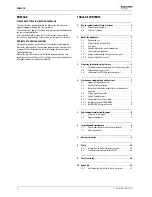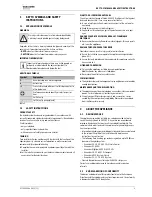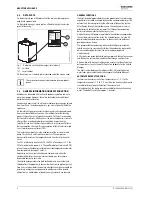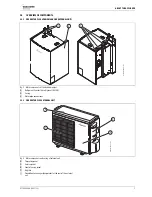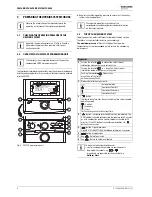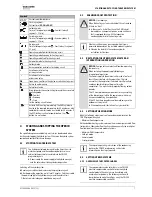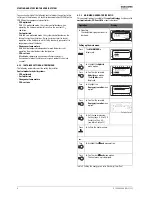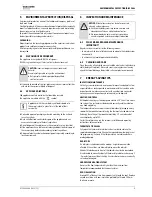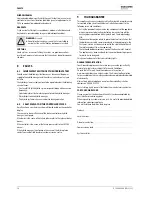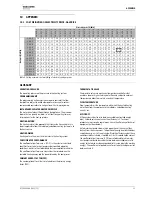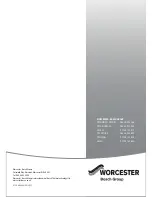
APPENDIX
6 720 803 688 (2012/11)
11
10
APPENDIX
10.1 COST WEIGHTING OF ELECTRICITY PRICE - GAS PRICE
GLOSSARY
OPERATING PRESSURE
The operating pressure is the pressure in the heating system.
PROGRAMMING UNIT
The programming unit ensures the automatic control of the flow
temperature subject to outside temperature (in case of weather-
compensated controllers) in conjunction with a time programme.
INSTANTANEOUS WATER HEATER PRINCIPLE
The water is heated as it flows through the appliance. The maximum
draw-off rate is quickly available, i.e. without long waiting times or
interruptions for the heat-up process.
HEATING RETURN
The heating return is the pipework that returns the heating water at a
lower temperature from the radiators/underfloor heating system etc. to
the heat source.
HEATING WATER
Heating water is the water that circulates in the heating system.
COEFFICIENT OF PERFORMANCE
The coefficient of performance
, (COP), is the actual or calculated
identifier for air to water heat pumps under specified operating
conditions, similar to the standardised fuel consumption for vehicles.
The coefficient of performance
describes the ratio between the
available heating energy and the power drawn by the compressor.
PRIMARY ENERGY FACTOR (PEF)
The consumption of fossil fuels is referred to as the primary energy
factor (PEF).
THERMOSTATIC VALVE
Thermostatic valves are mechanical temperature controllers that
enables a lower or higher heating water flow rate subject to ambient
temperature in order to maintain a constant temperature.
FLOW TEMPERATURE
Flow temperature is the temperature with which the heated heating
water flows from the appliance to the radiators, underfloor heating
circuits, etc.
EFFICIENCY
Efficiency describes the ratio between available output and energy
input. Under ideal circumstances, the efficiency is 1. Technical
processes always involve some losses, hence the efficiency of technical
equipment is always below 1.
Air to water heat pumps draw a large proportion of the energy [they
deliver] from the environment. This portion of energy is not described as
supplied energy, as it is free of charge. Were the efficiency under these
conditions to be calculated, it would be
1. As this would not be correct,
the coefficient of performance (COP) was introduced for air to water
heat pumps in order to describe the ratio between available or useful
energy to that which has been expended (in this case purely the working
energy). The coefficient of performance for air to water heat pumps lies
between 3 and 6.
Electricity price [P/kWh]
10.0-10.9
11.0-11.9
12.0-12.9
13.0-13.9
14.0-14.9
15.0-15.9
16.0-16.9
17.0-17.9
18.0-18.9
19.0-19.9
20.0-20.9
21.0-21.9
22.0-22.9
23.0-23.9
24.0-24.9
25.0-25.9
26.0-26.9
27.0-27.9
28.0-28.9
29.0-29.9
30.0-30.9
Ga
s pri
ce [P/kWh]
3.0-3.9
2.8
3.0
3.3
3.5
3.8
4.1
4.3
4.6
4.9
5.1
5.4
5.7
5.9
6.2
6.4
6.7
7.7
7.2
7.5
7.8
8.8
4.0-4.9
2.1
2.3
2.5
2.7
3.0
3.2
3.4
3.6
3.8
4.0
4.2
4.4
4.6
4.8
5.0
5.2
5.4
5.6
5.8
6.0
6.2
5.0-5.9
1.7
1.9
2.1
2.2
2.4
2.6
2.7
2.9
3.1
3.2
3.4
3.6
3.7
3.9
4.1
4.2
4.4
4.6
4.7
4.9
5.1
6.0-6.9
1.5
1.6
1.8
1.9
2.0
2.2
2.3
2.5
2.6
2.7
2.9
3.0
3.2
3.3
3.4
3.6
3.7
3.9
4.0
4.2
4.3
7.0-7.9
1.3
1.4
1.5
1.6
1.8
1.9
2.0
2.1
2.3
2.4
2.5
2.6
2.7
2.9
3.0
3.1
3.2
3.3
3.5
3.6
3.7
8.0-8.9
1.1
1.2
1.3
1.4
1.6
1.7
1.8
1.9
2.0
2.1
2.2
2.3
2.4
2.5
2.6
2.7
2.8
3.0
3.1
3.2
3.3
9.0-9.9
1.0
1.1
1.2
1.3
1.4
1.5
1.6
1.7
1.8
1.9
2.0
2.1
2.2
2.3
2.4
2.4
2.5
2.6
2.7
2.8
2.9
10.0-10.9
0.9
0.9
1.1
1.2
1.3
1.3
1.4
1.5
1.6
1.7
1.8
1.9
2.0
2.0
2.1
2.2
2.3
2.4
2.5
2.6
2.6
11.0-11.9
0.8
0.9
1.0
1.1
1.1
1.2
1.3
1.4
1.5
1.5
1.6
1.7
1.8
1.9
1.9
2.0
2.1
2.2
2.3
2.3
2.4
12.0-12.9
0.8
0.8
0.9
1.0
1.1
1.1
1.2
1.3
1.3
1.4
1.3
1.6
1.6
1.7
1.8
1.9
1.9
2.0
2.1
2.2
2.2
13.0-13.9
0.7
0.8
0.8
0.9
1.0
1.0
1.1
1.2
1.2
1.3
1.2
1.4
1.5
1.6
1.7
1.7
1.8
1.9
1.9
2.0
2.1
14.0-14.9
0.7
0.7
0.8
0.8
0.9
1.0
1.0
1.1
1.2
1.2
1.2
1.3
1.4
1.5
1.5
1.6
1.7
1.7
1.8
1.9
1.9
15.0-15.9
0.6
0.7
0.7
0.8
0.9
0.9
1,
1.0
1.1
1.1
1.1
1.3
1.3
1.4
1.4
1.5
1.6
1.6
1.7
1.7
1.8
16.0-16.9
0.6
0.6
0.7
0.7
0.8
0.9
0.9
1.0
1.0
1.1
1.0
1.2
1.2
1.3
1.4
1.4
1.5
1.5
1.6
1.6
1.7
Table 3 Call-up example: cost weighting of electricity and gas prices


